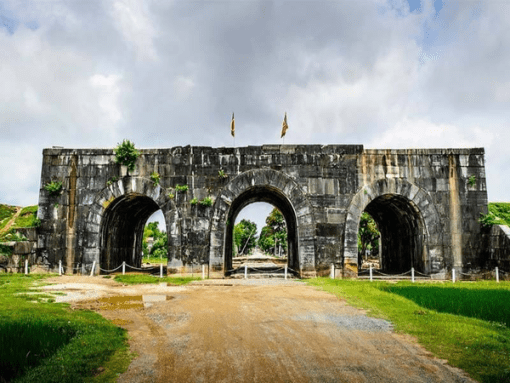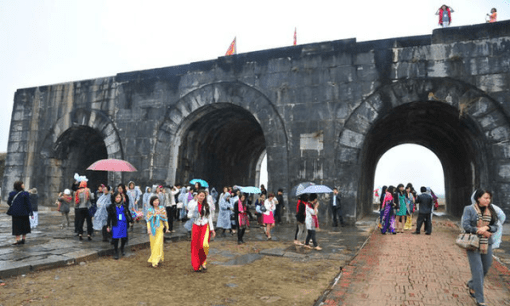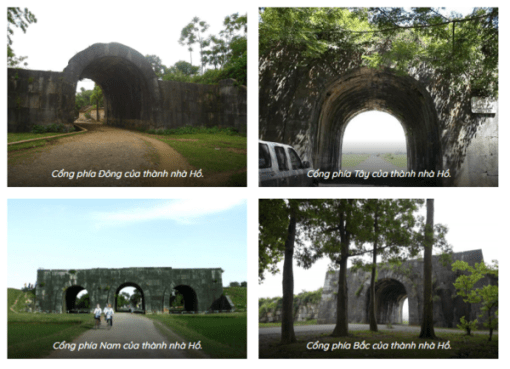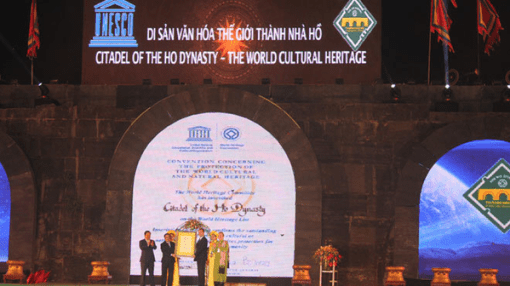The Citadel of the Ho Dynasty—”Solid Wall,” specifically created with massive rocks, is one of Vietnam’s uncommon cities, now on the list of the world’s few remaining stone ramparts. If you want to visit Thanh to explore its beauty, you must include “Ho Castle” on your list of attractions to visit and enjoy. Through the article below, we, the Vietnam Pilgrim Company, will assist you in exploring the particular trade aspects of Ho Citadel.
I. What is the location of the Ho Dynasty citadel?

The Citadel remnant of the Ho Dynasty is presently located in Vinh Tien, Vinh Long commune, Vinh Long District, Thanh Hoa province.
It will take more than an hour by automobile to travel 140 kilometers from the capital, Hanoi. Because the city is 45 kilometers from Thanh Hoa city center, you can relax at a hotel in the city center before traveling to Thanh Hoa city. Visitors may easily pick from a variety of modes of transportation, including motorcycles, buses, electric automobiles, and so on. You may arrange the proper move based on your preferences and weather conditions.
II. History
Ho Castle, also known as Tay Do court at the time, was ordered to be constructed and erected in 1397(more than 600 years ago today). Ho Quy Ly, who was presently in charge of infiltrating Thai Master Binh’s patriarchal realm, had come up with the clever but rather audacious notion of erecting this wall.
The original goal of constructing the city, as everyone assumed, was to make a splendid mark reflecting a period, but the profound objective of building this fortress was to compel King Tran Nhan Tong to carry out the command to shift the capital from Thang Long (the capital at the time) to Thanh Hoa. A few years later, the Ho Dynasty was legally proclaimed as the Dai Ngu Country’s capital.

Visitors will not be shocked to learn that the lake structure was constructed in a record-breaking amount of time (from the idea of starting construction to the completion of only 3 months). Moderns will always respect the ability and architectural quality of our ancient ancestors. Many building supplies, especially basics, were in short supply.
III. Ho Citadel’s architectural highlights
As previously said, the citadel is solidly made with massive stones, producing a distinct feature of the court. The four distinctive arches, which correspond to the four corners of the city (East, West, South, and North), are one of the most magnificent characteristics of the city’s architecture. Other noteworthy sights to see while on a trip include the palace, La Thanh, and the Nam Giao Altar. The exterior of most old ramparts, which include suburban and inner-city areas, is made with massive stones of a strong nature to defend, while the inside is typically fitted with land to reduce the money to be spent. The land and space around the city are characterized by wide rivers and rough mountains, which create good circumstances for military defense. It is simple to integrate with road and canal traffic.

IV. Ho Citadel’s accomplishments
Ho Citadel has produced numerous great achievements to date, most notably in the sector of tourism with historical sites of national significance.
With 11 years of submitting papers to the World Heritage Committee, Ho Citadel continues to strive in the process of maintaining and constructing new amenities to create pleasant circumstances for guests while visiting. All of these efforts were rewarded on June 27, 2011, when Ho Citadel was designated a UNESCO World Cultural Heritage Site, marking a watershed moment in the country’s history of protecting and enhancing historic places.

Throughout the years of working to submit records, the outstanding Ho Citadelperformed admirably and successfully met two requirements to demonstrate the world’s cultural heritage:
Criteria 1 (the second of ten World Cultural Heritage criteria): Ho Citadel is a symbol of positive human values for Vietnam and other countries, particularly those in Southeast Asia. Ho Castle displays our country’s willingness to learn about traditional culture while also applying ingenuity to the great Ho Citadel, leaving a historical mark on mankind.
Criteria 2 (the fourth of the ten World Cultural Heritage criteria): Military terms, the Ho Citadel Monument area is regarded as a strong and impressive fortification. The Vietnamese people are once again proud of their historical past, thanks to the application of construction techniques to create Ho Citadel with distinctive huge boulders.
V. Conclusion
Residents and even valuable visitors have contributed to creating a mark here throughout a long history of attempting to create the particular beauty of Ho Citadel. Aside from tourism, you may sample Thanh specialties like sour nem, seafood meals, and so forth. These appealing activities have become the tourist icon of Thanh Hoa, leaving a lasting impact on visitors.
More: Ha Long Bay – Vietnamese’s works of art




Bài viết liên quan: